
If your baby wants to be fed frequently, doesn't seem to be gaining weight, or if feeding is painful, this may be the most important information you'll ever read...
Watch this short 6 1/2 minute video by Dr. Amrita Sandhu to see if you should get your baby checked for "Tongue Tie", an easily corrected oral impairment that could be preventing your baby from getting the nutrition they need.
Imagine the joy you feel. Your child is born. The doctor says you have a healthy baby....
The nurse hands you your infant so you can start bonding the first time you breastfeed. Now imagine how you feel when the baby can’t get a proper latch. A basic job of a mother is to feed their child, right? The nurse provides some instruction. A lactation specialist is brought in to go through more instruction and provide a hand. Still, you are unable to breastfeed. And the pain! Your infant diligently tries to feed and puts their little lips where they are supposed to be but immediately slides down, pinching your nipples between their cute little gums but they HURT!
You go to the doctor again and they still see nothing wrong. You ask friends about it and one of them says; that sounds like tongue tie. Does your dentist do laser procedures? Maybe you should go see her to get it checked.
I know. A dentist for a newborn. Crazy, right? Actually no.
GET MORE INFORMATION ON TONGUE-TIE NOW
Your Pediatrician May Not Have This Important Information.
Know What To Look for And What To Ask.
Members of:


Have you ever heard of TOTS, either tongue-tie or lip-tie before? If not, that wouldn’t be unusual.
Currently only 4 – 10%* of newborn children are diagnosed with either or both.
And does my DENTIST even know how Tethered Oral Tissues (TOTS); Ankyloglossia (Tongue-Tie) or Tethered Superior Labial Frenum (Lip-Tie) can effect breastfeeding?
A Good Question....
But how does breastfeeding have anything to do with my dentist?
“During the embryologic development, this muscle is initially attached to the floor of the mouth. This attachment usually partially disappears and in most cases reduces naturally from the tip toward the base of the tongue. When this piece of tissue fails to disappear or reduce its attachment, it may restrict the ability of the tongue to function and have adequate mobility.”**
This is called tongue-tie.

Sometimes, the upper lip frenulum (small fold of tissue that secures or restricts the motion of the upper lip) is short, tight and restrictive. This can prevent mobility of the upper lip. This we call an upper lip-tie (ULT).
There is the possibility that a child can also have a lower lip-tie or cheek-tie which would have the issues as other TOTS.
Now that you know what they are, how do they relate to breastfeeding and your dentist?
Here is the experience of Dr. Bobby Ghaheri, ENT (ear, nose and throat specialist) when he first found out about it***:
Breastfeeding Should Not Be Painful
By Dr. Ghaheri – Feb 9, 2014
drghaheri.com
When my first daughter was born, breastfeeding was extremely difficult for both her and my wife. We saw numerous lactation consultants. Our pediatrician had no suggestions. Despite the pain, constant nursing, and poor sleep cycles from constant hunger, both of them persevered and breastfed for years. Several years ago, my second daughter was born, this time at home. Within 3 days, an almost identical experience was developing for my wife. This time, however, our midwives identified a potential anatomical reason for why it was so painful. We saw Melissa Cole with Luna Lactation, who very quickly identified a tethered upper lip and tongue as the cause of our problems. At 7 days of age, my daughter underwent release of these two tethered frenula and nearly immediately, breastfeeding began to improve.
During my paternity leave, I watched my wife and daughter's nursing experience improve gradually. Looking retrospectively, it became apparent that my first daughter was also tongue- and lip-tied. How did different hospital lactation consultants, her pediatrician, and her ENT dad (presumably a specialist in all aspects of mouth problems), completely miss her problems?
It boils down to a complete lack of education.
In four years of medical school and five years of residency training, I received exactly ZERO lectures on breastfeeding. It's appalling.
The more and more I thought about it, the angrier I became.
So I decided to do something about it.
Over the last two years, I have dedicated myself to understanding and treating babies who are having difficulty with breastfeeding.
I have many goals.
I want to make any medical professional who comes into contact with a breastfeeding dyad aware of the potential problems that tongue-tie and lip-tie can cause.
I want to debunk the nonsensical myths that have been propagated from medical generation to medical generation.
I want to generate studies that can help determine why some have problems with breastfeeding and others don't.
Slowly, I'm making progress.
It will take some time. But I'm confident that I will help those who don't understand why breastfeeding shouldn't be painful or a struggle.
As Dr. Ghaheri asserts, breastfeeding should not be painful. It should be a time of loving bonding for mother and child. However, if the child has tongue-tie or other TOTS and is not addressed, it can have immediate as well as long-term and serious consequences for both.
The child will have a poor latch on the mother’s breast which can result in difficulty or an inability to breastfeed at all.
Other possible outcomes are:
* an inability to drink enough milk
* extended nursing periods trying to drink enough milk
* falling asleep on the breast
* poor weight gain
* colic
* gassiness
* reflux
* failure to thrive
With a tongue-tie, the child may also be unable to sustain a latch for any length of time. This will often cause the child to wean from the breast at a very early age.
According to Dr Kotlow****, long-term risks for the child include:
* Reduced immunity to disease if mother's milk is not used (pumping helps reduce this concern)
* Increased risk of juvenile type diabetes, allergies
* GI problems, certain cancers
* Increased risk of heart disease and obesity as an adult
* Orthodontic problems & facial development
* Increased risk of dental decay
* Spinal development abnormalities
* Facial development abnormalities
* Speech defects
* Increased risk of SIDS
The difficulties a mother faces from this are just as concerning.
From the shallow latch or slipping off, she will get painful compression of nipples.
Mastitis (Mastitis is an inflammation of the breast that may be accompanied by infection. Mastitis mostly occurs during the first six weeks post-partum, however, it can also occur at any other point during lactation.
Causes of mastitis are linked to insufficient milk drainage, milk stasis and inflammation.),
Engorgement (Engorgement is when the breast tissue overfills with milk, blood and other fluids. This causes your breasts to feel very full, to become hard and painful and your nipples to appear flattened and tight. Breast engorgement can be severe. It usually occurs if the baby is not feeding properly, so the milk builds up.),
Thrush (Thrush is a fungal infection caused by the organism Candida albicans, which can occur in the nipples or breast tissue (as well as other places in the body).)
Vasospasm (A nipple vasospasm may be triggered by a breastfeeding baby in a shallow latch and it can also be connected with Raynaud's phenomenon (a condition affecting blood supply). Nipple vasospasm can also be associated with deep breast and muscle pain—a condition referred to as Mammary Constriction Syndrome.) can also be caused by an insufficient latch.
Anxiety, stress, fatigue, and post-partum depression can all be caused by not being able to help your child be happy and healthy. It is also exacerbated by people who don’t understand that there could be problems quite outside the mother’s control for failure to thrive.
Some go as far as to call it child abuse, which would cause any parent issues.
Slow weight loss from pregnancy can be caused by lack of sleep, stress and the inability to breastfeed (which can burn up to 500 calories a day*****).
Early cessation of lactation, bleeding, cracked and flattened nipples, low milk supply, feelings of guilt can also be caused by a child’s inability to breastfeed properly, if at all.
Looking at all the reasons, there is a preponderance of proof that, if diagnosed, parents should look at having a frenectomy (Frenectomy is a simple oral surgical procedure that eliminates the presence of a frenum in the mouth. A frenum is a muscular attachment between two tissues found inside of the cheeks and lips and inside the mouth and gums. There are two kinds of frenum in the mouth, the labial frenum and the lingual frenum.) performed.
This brings us to how breastfeeding and tongue-tie are related to dentistry.
We recommend seeking someone trained in the use of surgical soft-tissue dental lasers with education on TOTS. Laser revisions are quick, safe, and easily completed in a few minutes in a dental office without the need to have your child put under general anesthesia. This is the best standard of care.
Lasers are bactericidal (kills bacteria), usually bloodless; do not require placement of sutures, anaesthetic free, fast and a safe alternative for infants.
The so-called “quick snip” is a method we recommend against if you have the laser alternative. This is when any practitioner takes a pair of scissors and releases a few millimeters of tissue under the tongue. In almost all instances, this is an incomplete, insufficient, and inadequate release of the tissue and also causes significantly more bleeding than using laser (which can lead to parental trauma, especially if unexpected).
It is extremely important that after the both lingual and lip attachments are released for parents to assume responsibility to keep the surgical sites open and not allow either site to heal back together and reattach. A demonstration of the correct method should be shown before leaving the clinic.
For 6 - 14 days after the frenectomy is done, parents need to do stretching exercises a minimum of 2 – 3 times. Just before breastfeeding would be a good time to do it as The sweetness of the breast milk acts as an 'analgesic' and the act of breastfeeding brings with it comfort to the infant if the infant is experience any post-procedure discomfort******.
For an upper-tie; firmly pull the upper lip toward the nose to release any signs of reattachment then gently massage the diamond shaped area for a few seconds.
The method for the tongue-tie is to seat the child in your lap, facing away from you. With one hand lift the tongue and with the other hand gently but firmly pull down on the lower jaw using enough force to open the diamond shaped area. Use an index finger to gently massage that area as well. It is also recommended that the mother do a sweep with her finger along the bottom of the mouth area to open it again before all other feedings.
In addition to daily stretching of the tongue and/or lip; facial and lip massaging often helps relax your child’s facial and lip muscles. It is recommended that a mother gently massage the cheeks for the first week after releasing the tie. It is also often helpful to get the infant familiar with the new ability to properly suck and latch by using a finger go around the lip and slowly allow the infant to root for the finger.
Exposing the top 10 Myths (takes) in diagnosing and treating tethered oral Tissues (tongue-ties and lip-ties) in breastfeeding infants
Lawrence Kotlow DDS-board certified pediatric dentist kiddsteeth.com
1. Myth: Tongue-ties (ankyloglossia) do not have anything to do with problems related to breastfeeding.
Fact: Breastfeeding depends on the ability of an infant to create a vacuum to express milk from the breast. The upward and downward motion of the posterior portion of the tongue creates this vacuum. If the tongue is prevented from making this motion, the infant may not be able to express milk painlessly and efficiently leading to many breastfeeding problems such as; failure to thrive, reflux, colic, non-nutritional breastfeeding, short episodes of breastfeeding, crying, gagging, obstructive sleep apnea, plugged ducts and mastitis.


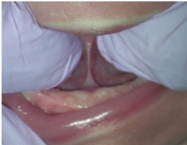

2. Myth: Upper lip-ties do not have anything to do with breastfeeding.
Fact: Breastfeeding depends on the ability of an infant to form a good seal on the mother’s breast. When the upper lip is prevented from flanging upward this seal may be shallow or incomplete. This often leads to clicking and swallowing excessive amounts of air in the infant’s belly. This creates the appearance of colic and reflux. It is not a true acid reflux but AEROPHAGIA or the swallowing of air. This also leads to similar problems such as failure to thrive, reflux, colic, non-nutritional breastfeeding, short episodes of breastfeeding, crying, gagging, obstructive sleep apnea, plugged ducts and mastitis. Infants may display lip blisters. Lip-ties may also hold mother’s milk on the facial surfaces of the upper front teeth during nighttime at-will feeding and contribute to dental decay.
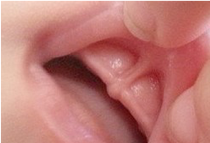


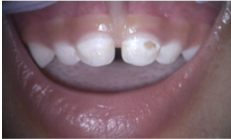
3. Myth: Placing an infant on acid reflux drugs will aid in the resolution of reflux.
Fact: In reality these drugs do little to relieve the pain and discomfort. In addition, when reflux continues during the nighttime hours, an infant may display morning sinus congestion, which is sometimes diagnosed as allergies or other medical conditions. Reflux and vomiting are usually due to swallowing air when a poor latch results in clicking on the breast or bottle. (Aerophagia)
4. Myth: A healthcare provider can adequately rule out the presence of a tongue-tie and lip-tie by examining an infant in a parent’s lap.
Fact: When examining an infant for tethered oral tissues (TOTS), the examiner should be able to examine the entire oral area including the outer lip condition, cheeks, the upper and lower lip attachments, tongue attachment, hard and soft palates. In order to accomplish this the examiner needs excellent visualization and infant control. Optimal visualization and patient control is achieved when the infant is placed in the examiner’s lap with the infant’s head facing the same direction as the examiner and the mother controlling infant movements.
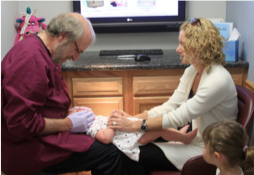

5. Myth: Infant suffering from reflux should see a pediatric GI doctor and undergo extensive tests.
Fact: The prudent treatment should include ruling out the presence of a tongue-tie and lip-tie. If there are tethered oral tissues present, revising the attachments will often improve or eliminate the problem.
6. Myth: Revising the upper lip-tie will create; floppy lips, require sutures to close the surgical area, will result in the upper primary anterior teeth’s roots to rot out, surgery should wait until the infant is 12 or 13 years of age , after orthodontics closes any gaps,(diastema), the surgery will cause scarring, completing surgery will require general anesthetics in the operating room, or even the idea that a parent should wait until an infant falls and rips the lip-tie.
Fact: Not one of these so-called facts is based upon any evidence-based studies. They are all based on hearsay and have no scientific data to support such statements.
7. Myth: Lasers are not safe for use in infants and children.
Fact: The FDA approved the manufacture of both soft and hard tissue lasers in the late 1990s. Lasers are safer than scissors, scalpels, and electrosurgical instruments. Lasers are fast, efficient, and bactericidal. They pose no risks to patients. They do require the surgeon to have taken courses in laser safety, laser physics and instruction on the particular laser is being used. Laser glasses are required for everyone in the surgical area when lasers are being used.
8. Myth: Once the lip and tongue have been revised, no additional care is required.
Fact: After the lip and tongue attachments are diagnosed as the probable cause of any breastfeeding symptoms, just surgically revising these areas does not complete treatment. Post-surgery active wound management is required to prevent the surgical sites from healing back to their original location. This requires keeping the surgical areas apart for least two weeks by actively separating the tissue three times a day. If the lingual frenum begins to reappear, it needs to be reopened. In addition to this active wound management, infants and mothers should be followed by their lactation consultant (IBCLC) and when recommended have additional body work by the appropriate Chiropractor or cranial sacral therapist.
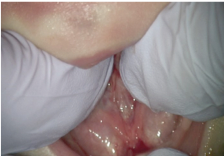
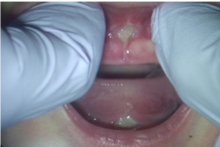

9. Myth: Mothers need to understand breastfeeding may be painful. They need to wait until their nipples get tough and not be so wimpy. If they cannot breastfeed, just pump or switch to formula and give the baby a bottle.
Fact: Breastfeeding should be a time where a mother and her infant can bond together. This bond created lasts a lifetime. Mothers who cannot breastfeed often become depressed and are told it is their fault. Breastfeeding should not be an all-day effort and painful. Mothers know best. When a mother thinks there is something wrong, there usually is.
10. Myth: My infant was examined in the hospital and I WAS TOLD EVERYTHING WAS JUST FINE.
Fact: Many hospitals, all over the world, have what is quietly called the “GAG” rule. Nurses and Lactation consultants based in hospitals are told they cannot discuss tongue and lip ties with patients.
Why South Airdrie Smiles Is Your Best Choice For Your Baby
You want your baby to be in GREAT hands. Dr. Sandhu is specially trained in the use of surgical soft-tissue dental lasers with specific education on TOTS. Laser revisions are quick, safe, and easily completed in a few minutes in a dental office without the need to have your child put under general anesthesia. This is the best standard of care.
You want the best for your child. Consider these facts when choosing who should see your child:
- The FDA approved the manufacture of both soft and hard tissue lasers in the late 1990s.
- Lasers are safer than scissors, scalpels, and electrosurgical instruments.
- Lasers are fast, efficient, and bactericidal. They pose no risks to your child.
- They do require the surgeon to have taken courses in laser safety, laser physics and instruction on the particular laser is being used.
Compare the advantages of a dental laser to the disadvantages of conventional surgical frenectomies:
- Bleeding
- Possible blockage of Wharton's duct while suturing on the ventral surface of tongue leading to retention cyst
- Possible damage to the lingual nerve causing numbness of the tongue tip.
When it comes your your child, diode lasers have several advantages when compared to conventional scalpel surgeries. They are compact and portable in design, with efficient and reliable benefits for use in soft tissue oral surgical procedure.
Laser-assisted lingual frenectomy is easy to perform with excellent precision, less discomfort, minimal or no bleeding due to sealing of capillaries by protein denaturation and stimulation of clotting factor VII production, shortened healing time with significantly less post-operative bleeding.
A frenectomy performed on your child with a laser will contain significantly lower number of the cells that are present around a wound, which leads to improved healing, and less pain and greater function than with the quick-snip scalpel technique.
Lasers are bactericidal (kills bacteria), usually bloodless; do not require placement of sutures, are anaesthetic free, fast and a safe alternative for infants.
Please avoid the so-called “quick snip” method if at all possible.
This is when any practitioner takes a pair of scissors and releases a few millimeters of tissue under the tongue. In almost all instances, this is an incomplete, insufficient, and inadequate release of the tissue and also causes significantly more bleeding than using laser (which can lead to parental trauma, especially if unexpected).
Call Us. We're here to help.
At South Airdrie Smiles, we are trained on this critical procedure to be able to help you and your child have the best possible chance to bond and prevent future poor outcomes. We love having kids come in to see us. Being able to provide a vital service at such an early age also gives us the chance to give you information on how to help make sure your infant has the best possible smile by starting dental care at an early age.
Help your baby get the nutrition he/she needs. Call us at 587-317-9915 or FILL IN THE FORM AT THE TOP to get more information sent to you by email. There's no cost or obligation and we're happy to help!